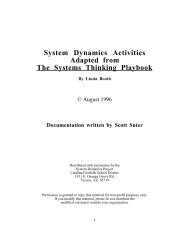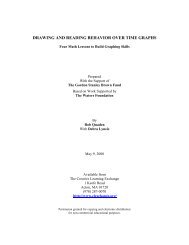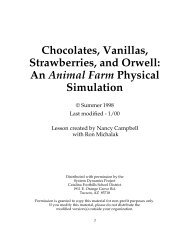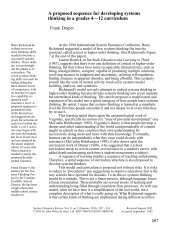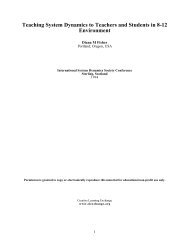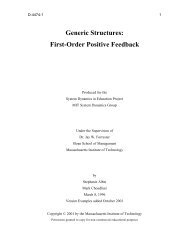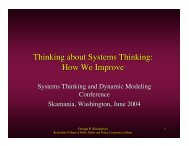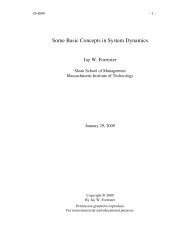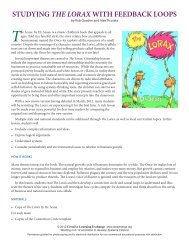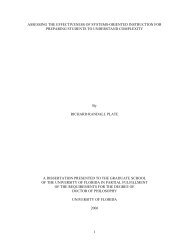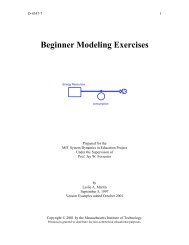Keystone Species in an Ecosystem Using Connection Circles to Tell ...
Keystone Species in an Ecosystem Using Connection Circles to Tell ...
Keystone Species in an Ecosystem Using Connection Circles to Tell ...
Create successful ePaper yourself
Turn your PDF publications into a flip-book with our unique Google optimized e-Paper software.
Introduction<strong>Ecosystem</strong>s are built upon complex <strong>in</strong>terrelationships among org<strong>an</strong>isms <strong>an</strong>d their habitats. Often,a ch<strong>an</strong>ge <strong>in</strong> the population of one species causes unexpected ch<strong>an</strong>ges <strong>in</strong> other species.Underst<strong>an</strong>d<strong>in</strong>g <strong>an</strong>d represent<strong>in</strong>g a web of ch<strong>an</strong>ges is challeng<strong>in</strong>g for the scientists who study them,let alone for readers who try <strong>to</strong> comprehend these complex situations. In this lesson, studentsread a chapter from a skillfully written science book <strong>an</strong>d use connection circles <strong>to</strong> unravel amystery of nature. 1As <strong>in</strong> previous lessons, students will frame their <strong>in</strong>quiry with these questions: What is ch<strong>an</strong>g<strong>in</strong>g?How is it ch<strong>an</strong>g<strong>in</strong>g? Why is it ch<strong>an</strong>g<strong>in</strong>g?Materialso Overhead projec<strong>to</strong>r or display boardo Several different colored markers for each studen<strong>to</strong> <strong>Connection</strong> Circle template for each student (page 15)o Posted copy of “<strong>Connection</strong> Circle Rules” (page 16)o Copies of “The Case of the Tw<strong>in</strong> Isl<strong>an</strong>ds” from The Shape of Ch<strong>an</strong>ge (2008), page 137.How It WorksIn her <strong>in</strong>formative <strong>an</strong>d enterta<strong>in</strong><strong>in</strong>g book, The Case of the Mummified Pigs <strong>an</strong>d OtherMysteries <strong>in</strong> Nature, 2 Sus<strong>an</strong> E. Qu<strong>in</strong>l<strong>an</strong> has written fourteen true s<strong>to</strong>ries that describe theresearch of ecologists who puzzle out how <strong>an</strong>d why ecosystems behave as they do. Readersdiscover the <strong>in</strong>terest<strong>in</strong>g <strong>an</strong>d often surpris<strong>in</strong>g connections among org<strong>an</strong>isms through the work ofdetectives who f<strong>in</strong>d clues <strong>to</strong> nature’s riddles.The chapter, “The Case of the Tw<strong>in</strong> Isl<strong>an</strong>ds,” exam<strong>in</strong>es why the ecosystems <strong>in</strong> the waters off twoneighbor<strong>in</strong>g Aleuti<strong>an</strong> Isl<strong>an</strong>ds are so different. As students use connection circles <strong>to</strong> trace causalrelationships <strong>in</strong> the s<strong>to</strong>ry, they discover the role of a keys<strong>to</strong>ne species, a species vital <strong>to</strong> thestability of the whole ecosystem. Students learn how feedback loops ma<strong>in</strong>ta<strong>in</strong> a delicate bal<strong>an</strong>ce<strong>in</strong> <strong>an</strong> ecosystem <strong>an</strong>d what happens when that bal<strong>an</strong>ce is disturbed.<strong>Connection</strong> <strong>Circles</strong>The purpose of a connection circle is <strong>to</strong> help students focus on the problem presentedby the author <strong>an</strong>d <strong>to</strong> uncover its causes. Here is a quick overview:o First, students briefly def<strong>in</strong>e the problem: What is the author concerned about?What is the ma<strong>in</strong> problem? What is ch<strong>an</strong>g<strong>in</strong>g over time?o Next, how is it ch<strong>an</strong>g<strong>in</strong>g? In a few words, or with a quick behavior over timegraph, students describe how the problem is <strong>in</strong>creas<strong>in</strong>g or decreas<strong>in</strong>g over time.o F<strong>in</strong>ally, students look for elements <strong>in</strong> the s<strong>to</strong>ry that contribute <strong>to</strong> the problem.They use a connection circle <strong>to</strong> org<strong>an</strong>ize their thoughts, f<strong>in</strong>d cause <strong>an</strong>d effectrelationships, <strong>an</strong>d trace the feedback loops that tie them <strong>to</strong>gether <strong>to</strong> expla<strong>in</strong> whythe problem occurs.2



